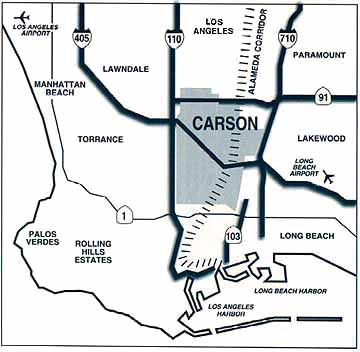As the current border brouhaha between Carson City Councilman Albert Robles and the Daily Breeze newspaper illustrates, there’s great importance attached to the names used for geographic areas – especially when they’re used in conjunction with undesirable activities or tarnished reputations.
In this case, the councilman drafted resolutions that would require the city to cancel its subscriptions to the Breeze and would urge residents to boycott the newspaper over its usage of “published accounts of homicides, other crimes and negative stories” that were reported as “misleadingly located ‘near Carson.’”
The Daily Breeze’s editor, Michael Anastasi, responded with a letter to the Council and residents that said the newspaper “has consistently referred to the unnamed unincorporated area of Los Angeles County near Carson as just that.” To his credit, he said, that: “While it is unfortunate that Carson may cease being a business client of the Daily Breeze, we will not bow to financial pressure.”
He offered to meet with city leaders and noted that no meeting had been requested prior to Robles public complaint. Robles has delayed action indefinitely on his resolutions and said he plans to meet with Anastasi.
As we noted in an earlier post, names are powerful. They can evoke entirely different emotions and leave entirely different perceptions among different groups of people and among different individuals. Successful communicators consider their audiences in choosing which words to use. In the case of Carson, the Daily Breeze likely never considered how its descriptions would affect Carson. Moreover, some of the stories Robles cited were written by City News Service, rather than the Breeze’s staff.
But similar efforts have changed neighborhoods’ names. Note, for instance, the successful campaign that changed South Central Los Angeles to South Los Angeles after the notoriety the neighborhood gained as the epicenter of the 1992 “civil unrest.” (Civil unrest was another term created to replace the word “riot” in referring to the violence that erupted after the acquittal of police officers in the beating of motorist Rodney King.) Property values often hinge on monikers, leading to the creation of such terms as Malibu adjacent or Beverly Hills Post Office, i.e. not in the City of Beverly Hills but assigned to use the postal services of Beverly Hills.
In the case of Carson, several have noted that the criticism came after a Daily Breeze story about political intrigue leading up to city elections, suggesting the border brouhaha may have more to do with the critical coverage than the geographic description. But the councilmember’s resolutions have kept the focus on the geographical description of incidents happening in an unincorporated part of Los Angeles County located between Carson and Torrance.
Robles pointed out that these areas could be described as Harbor Gateway or an unincorporated area near Torrance. Some consideration may be in order to more clearly describe the unincorporated areas in the Breeze’s circulation area.
The LA Times sought to do just that by creating a map of LA’s neighborhoods in 2009. But it faced substantial challenges and reached an imperfect compromise. The newspaper invited comments on its first attempt at mapping neighborhoods and received more than 1,500 comments, resulting in nearly 100 changes in the map.
After all this work, the paper said: “We’ll be the first to acknowledge that our map isn’t perfect. No lines can capture the geographic diversity and demographic energy of Los Angeles.”
What other communities have you seen renamed because of political, social or real estate concerns?


Good post. I learn something new and challenging on blogs I
stumbleupon every day. It’s always interesting to read through content from other writers and practice something from other web sites.
LikeLike